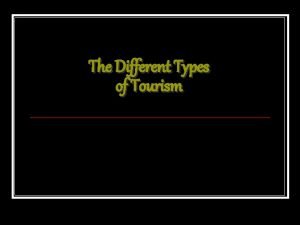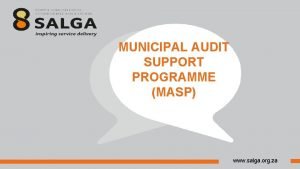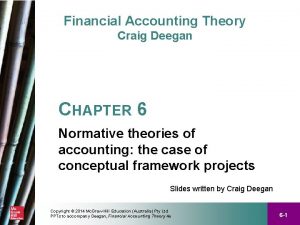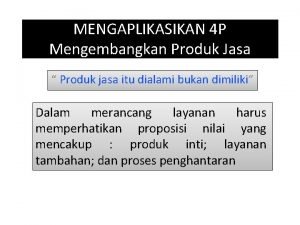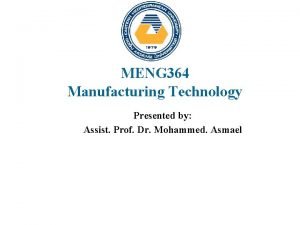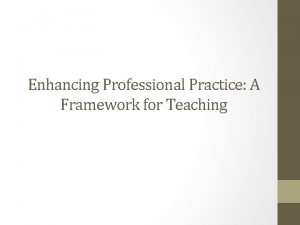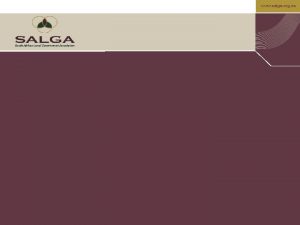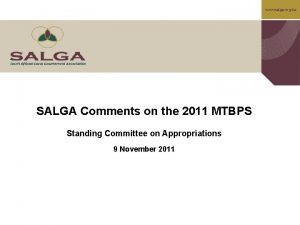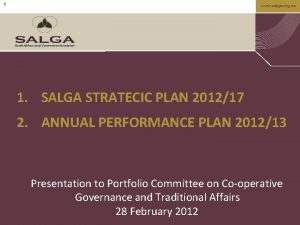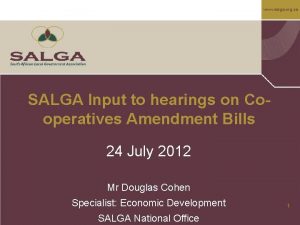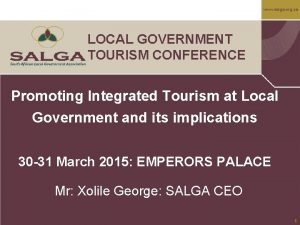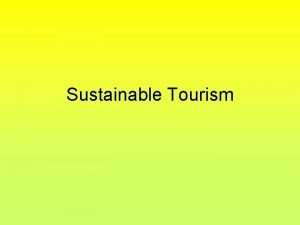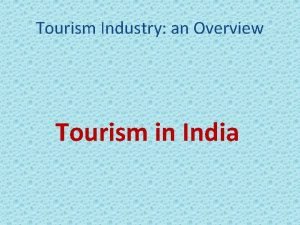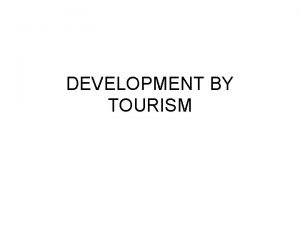www salga org za National Tourism Conference Enhancing


















- Slides: 18

www. salga. org. za National Tourism Conference Enhancing Local Government Competitiveness 31 March 2015 1

www. salga. org. za INTRODUCTION • South Africa has long been a destination for tourists looking for wildlife and spectacular natural settings and its diverse cultural heritage. Local governments are custodian of many of the natural resources frequented by tourists and locals, e. g. Parks, Beaches and Forests and contribute services to maintenance and upkeep of infrastructure related to products run by other entities • Local Government’s role in tourism has been the supply of services and infrastructure on which the economy and the tourism industry is based. • This includes services such as public roads, water and sanitation, waste services, tourism signage, museums, visitor information centres, land identification for future tourism site development. 2

www. salga. org. za INTRODUCTION • Visitors consume an array of service and goods, some provided by the tourism sector, and others by local governments themselves. Generally speaking, the experience, whether it is an incidental good or service (or externality), not directly related to tourism per se will be attributed to the location, which is managed by the local government. • Besides provision of basic services, many local governments the world over have played a strategic role in repositioning themselves as a tourism mecca: – Dubai – Parys 3

www. salga. org. za PROBLEM STATEMENT • A number of municipalities struggle to deliver and maintain the basic infrastructure required for the tourism industry to thrive. • There are often capacity constraints in terms of skills, to deliver non-specific and tourism specific requirements • They also have populations with vast social inequities which presents a resource allocation to the municipality, it also presents a challenge to placespecific perception-based industry 4

www. salga. org. za A FRAMEWORK FOR COMPETITIVENESS: THE CLUSTER APPROACH • Tourism is one of the traditional clusters: (Porter 1990) – Geographically concentrations of connected firms – Specialised suppliers, service providers, firms – Institutions like standards agencies, trade associations, universities and think tanks, governments, training service providers, linked industries – Large and small economies, rural and urban areas, and at different geographical scales from national to local and in a range of industries from car dealers to restaurants 5

www. salga. org. za THE CLUSTER • Clusters, more than traditional industry boundaries, include linkages, complementarities, spill overs ito technology, skills, information, marketing, customer feedback and needs that exceed firm or industry level. • They share common needs, opportunities, constraints, obstacles to productivity • Clusters better reflect the level at which competition occurs (in contrast to firms and industries) • Presents stronger argument for government support and intervention 6

www. salga. org. za CONCEPTS • Economic Development: long term sustainable development in standard of living • Standard of living is determined by the productivity of an economy • Which is measured by the value of goods and services produced per unit of the economic input (human, capital, resources) • Productivity is the basis of competitiveness • Productivity includes – The value of the goods/services – Efficiency with which they are produced 8

www. salga. org. za COMPETITION • Productivity boils down to a combination of technology and skill • Unless companies become more productive, the economy cannot become more productive – Operational effectiveness (best practice in terms of processes, technology, management) – Strategy: competing on differentiation not just price • Companies compete based on: – Micro economic business environment (roads, public goods and services, tax, legal system) – Cluster specific: suppliers, skills, institutions • Local/government can contribute to both 9

www. salga. org. za COMPETITIVENESS: PORTERS DIAMOND 1. Context for Firm Strategy and Rivalry – Context that supports investment and sustained upgrading (rules, incentives, norms) – Competition among local based rivals (low competition low productivity) 2. Demand Conditions – Sophisticated, demanding local customers affect productivity and shift to innovation 3. Related and Supporting Industries – Presence of local suppliers – Competitive related industries 4. Factor or Input Conditions – Quality and specialisation (includes R&D, universities) 10

www. salga. org. za ROLE FOR LOCAL/GOVERNMENT • Context – Remove obstacles, relax constraints and eliminate inefficiencies that impede productivity (human resources, infrastructure, regulatory constraints) – Coordinate department interventions to deliver on tourism requirements • Demand – Research and feedback – Marketing – Encourage early uptake of new technologies/products – Sponsor/encourage testing and certification – Buy products 11

www. salga. org. za Role for Local/Government • Supporting Industries – Sponsor forums to bring together participants – Establish for foster co-location of suppliers, service providers from other locations (land, rebates, infrastructure, concierge service) – (See context) • Input Factors – Improve quality through specialised education and training – Involve local research facilities – Database of tourism specific information – Plan and provide for transport, communications and ICTs where applicable 12

www. salga. org. za Role of Government • Macroeconomic and political stability • Microeconomic support measures – Education – Infrastructure • Rules and incentives governing competition that will encourage productivity growth • Predictable future plans/policy • These make all boats rise/sink • However, government must arguably also facilitate cluster stability, development and improvement 13

www. salga. org. za Key Elements of Tourism Competitiveness Elements Comments Role for Government Governance Regulation, whole of government approach, safety and security, stats and data, institutions, budget Regulation, research Product development Differentiation, innovation, high value segments, Promote Competition, remove constraints Quality of tourism services Improve Quality, Social cohesion Campaign, basics Price competitiveness Value for money Information Accessibility/connectivity Infrastructure, proximity Investment and branding/. marketing Branding the destination Promotion and marketing, identity, image Identity and marketing Natural and cultural resources Sustainability Manage and maintain, regulate Human resource Skills, education, 14 training centres facilitate

www. salga. org. za Case 1 • Anonymous Municipality – Regulation and Referral System: • B&B attracting the lions share, due to location at entry of town and large sign (information asymmetry) • B&B did not refer clients when overtraded • and location and no referral system/practice – Response: • Regulation: Signage by-law to standardise signage (level the playing field for competition • Indirectly promoting complementarity and competition on product 15

www. salga. org. za Case 2 • Robertson – Constraints • Inactive frontage along major route through town constrained development • Provided appropriate land use rights and actively encouraged hospitality development along major route through town 16

www. salga. org. za Case 3 • Jeffrey’s Bay – Competition • Back packers • Product differentiation – Surf school – English language service – Township tours – Added high-value accommodation 17

www. salga. org. za THANK YOU 20

www. salga. org. za Questions for Discussion • What are the most important basic activities/functions Municipalities can undertake to improve the operating environment for Tourism • What are the key interventions do Municipalities need to focus on to improve competitiveness in their local Tourism Industry? • What role should Municipalities play in marketing, research and improving technology for tourism? • Which partners do local governments need to make better use of in the National/Provincial Tourism System to improve their local industry competitiveness? 21
 Mass tourism vs alternative tourism
Mass tourism vs alternative tourism Cuando todo salga mal
Cuando todo salga mal Salga free state
Salga free state Que el camino salga a tu encuentro
Que el camino salga a tu encuentro Salga vacancies free state
Salga vacancies free state Palabra corrompida significado
Palabra corrompida significado Oración conjunta
Oración conjunta Colorado tourism conference
Colorado tourism conference Four enhancing qualitative characteristics
Four enhancing qualitative characteristics Enhancing professional practice
Enhancing professional practice Danielson framework components
Danielson framework components Enhancing personal effectiveness
Enhancing personal effectiveness Contoh pengembangan produk jasa
Contoh pengembangan produk jasa Enhancing thermal conductivity of fluids with nanoparticles
Enhancing thermal conductivity of fluids with nanoparticles Enhancing the performance of grade vi-c
Enhancing the performance of grade vi-c Privacy-enhancing computation
Privacy-enhancing computation Property enhancing process in manufacturing
Property enhancing process in manufacturing Enhancing a presentation with multimedia
Enhancing a presentation with multimedia Enhancing professional practice a framework for teaching
Enhancing professional practice a framework for teaching
